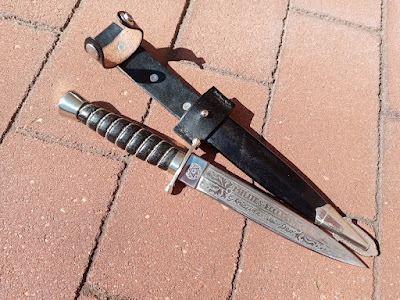This dagger was a mini-course in processes I hadn't tried before or hadn't pushed this far. It has a Solingen-made blade with deep saltwater etching. The resist for this step is nail polish; I found that permanent marker and paint pen both rubbed off too easily, while the nail polish is very tough and can only be removed with a powerful organic solvent. The original etching came out very dark, and I found it also seemed to have a little red rust despite the blade being a fairly high-chrome stainless. (The steel-soaked q-tips also turned red very quickly.) I sprayed the blade with Ospho to neutralize the rust, but this produced a dull coating which I had to sand off, which in turn required me to re-polish the blade, removing much of the dark patina in the process. As a result, this now looks more like a typical acid-etched blade, which I guess isn't a bad thing.
The guard and pommel are nickel silver (the pommel is called "white brass," but I suspect that in this case, they're approximately the same thing). I had to tap the pommel to match the unusual 10-32 blade thread - most blades of this sort are threaded 10-24. It was excruciating, took two tries, and gave me a blood blister on one finger. Despite my best efforts, the first pommel wound up with a badly off-center hole; the second is still slightly off-center. The ferrule and chape are fabricated from nickel silver sheet.
For a while, I was puzzled about how to make the grip. The tang doesn't taper until it reaches the threaded end, which makes filing out a hole very difficult and time-consuming. On the advice of several members of BladeForums, I built an initial grip up by ripping a 1/2-inch wide section off of each of two paper micarta scales, thinning them down to match the tang's thickness, epoxying the layers together, and then attempting to turn the assembly to shape. Unfortunately, the micarta is so smooth and impermeable that the epoxy didn't hold it together, and the assembly exploded when I tried to turn it.
In the end I used a solid wood grip and filed it out the slow way after turning. It's American walnut, double-dyed: first with vinegaroon, which turned it charcoal grey and ensured that no deep grooves maintained their natural color, then with Minwax ebony stain to turn it deep black. I did not neutralize the vinegaroon; my earlier experiments showed that a subsequent baking soda rinse turns the walnut brown (and not a nice brown like it was before). It's given linseed oil and then sealed with Tru-Oil. The spiral wrap is silver-plated copper wire which I twisted at home.
The sheath is 4-5oz veg-tan, dry-stitched with black artificial
sinew (I did not use contact cement, in order to avoid any spots which wouldn't absorb dye), dyed with Fiebings Pro Dye and finished with Resolene, neatsfoot
oil and Sno-Seal. I did not apply Resolene on the flesh side this time,
and I think this prevented it from becoming too stiff. Before
stitching up the sheath, I added a screw-back button stud (nickel-plated
brass). I'd read that to prevent the button coming loose, I should put
a drop of Loctite inside before screwing it together. I used Go 2 Glue
(Loctite's all-purpose formula) and only later realized that the
Loctite in question was referring to Threadlocker. Apparently
Threadlocker Red 271 is the preferred type for setting the button
permanently.
Due to the pommel being quite heavy for the blade, the retention strap with snap is absolutely necessary. I haven't mastered setting the snaps so that the internal metal deforms evenly, so the snap is still slightly less secure than I'd like. As for the double-capped rivets, they're very light; probably strong enough, but they should be domed, and without a specialized setter, hammering them to set leaves them completely flat.
The chape is the usual simple rolled cone. I made a
curved tip and ground the end of the chape to fit it, soldered it on,
then ground the end smooth. Then I cut out a drag to fit it, and etched
it in ferric chloride. Although I tried to give it a thorough resist
with permanent marker, the raised areas came out rather streaky and the
etch isn't very deep. I suspect whatever formulation of nickel silver
this is is more resistant to the ferric chloride than yellow brass.
Soldering the
drag was also tricky, as the way the chape tapers means that the drag
has to be seated on supports (I used bits of scrap brass) at a
slight angle so that it will be straight relative to the chape. The chape then had to be
slid in between the supports. I turned them both face-down and lay
thin strips of solder on the back of the drag along the seams so that
they wouldn't get onto the front and fill in the etching. There are
still traces of solder on the back of the drag, so I'm sure this was the
right decision.
On the whole, I'm satisfied with everything
except some minor imperfections. The blade etching is definitely not as
neat as the stenciled etchings of a professionally-made sword.
However, keeping in mind that the real thing would actually be
damascened in silver by hand instead of etched,
some raggedness is to be expected in all but the most expensive
versions. (As well, the fittings should all be a genuine albeit
low-fineness silver alloy - plating would not be used, because it wears
off with too many polishings.)
This is the generic type, issued
to Milites Ecclesiæ members who weren't affiliated with a specific
order. With slightly altered devices, the same lodge dagger would be
issued to the Ordo Fratrum Calvariæ Loci, the Sancti Societas Vampyri
Catholicæ, the Legio Sīcāriōrum, and hundreds of similar chivalric
orders organized under the ME.


No comments:
Post a Comment